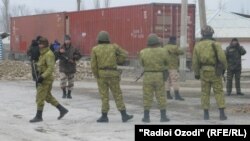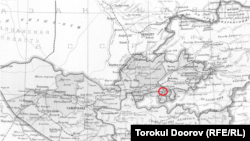Central Asia's impoverished and densely populated Ferghana Valley usually grabs the headlines when violence explodes in one of its cities, such as Osh in 2010 or Andijon in 2005.
But some of Ferghana's most volatile hotspots are neither urban nor located on the valley floor. They are on the slopes of the surrounding mountains, where residents compete fiercely for access to the few fertile zones that dot the arid landscape.
The fertile zones, which lie along rivers and streams, are the only highland areas which can support agriculture and grazing -- the economic mainstays of the region. That makes them tinderboxes for water and land disputes that can pull in not only local populations but also the governments of Tajikistan, Kyrgyzstan, and Uzbekistan, which divide the Ferghana valley among them.
The outbreak of shooting on January 11 in southern Kyrgyzstan's Batken Province provides just the most recent example of how volatile the problem is.
The violence concerned a 130-square-kilometer fertile area around the village of Vorukh, which is populated by some 32,000 people, the vast majority of them Tajiks. Legally, Vorukh is part of Tajikistan, but due to past redrawing of borders, it exists as an exclave some 20 kilometers inside Kyrgyzstan.
Constant Tension
If all sides agreed on exactly where the exclave begins and ends, its existence might pose no difficulties. But because Bishkek and Dushanbe have so far reached no such agreement, Vorukh is a cause of constant tension, with both countries maintaining checkpoints on the road in and out of it.
It is still unknown exactly what caused the Tajik and Kyrgyz security forces to begin shooting at each other January 11 on disputed land in between the village of Vorukh and the Kyrgyz village of Ak-Sai. But the gunfire, which left five Kyrgyz border guards and a policeman plus two Tajik border guards hospitalized, comes as local Tajiks accuse Kyrgyz of trying to grab land for a new road.
Bishkek intends the new road to bypass Vorukh so that Kyrgyz drivers do not have to stop at Tajik checkpoints in the exclave as they travel from one point in Kyrgyzstan to another. But Tajiks in Vorukh say the bypass, which will link the villages of Ak-Sai and Tamdyk, is planned across land that in fact belongs to the exclave, and Dushanbe backs their claim.
Jumaboi Sanginov, first deputy governor of Tajikistan's Sughd region, which borders Kyrgyzstan, says there should be no new construction until the borders of the exclave are settled. According to Sanginov, this principle is in line with a presidential-level agreement between Dushanbe and Bishkek.
"We base our work upon the joint statement by the presidents of Tajikistan and Kyrgyzstan made in 2008," he says. "On that [statement] the agreement was signed by the state secretaries of the two republics' Security Councils. We work basing our activities on the documents that ban any construction works or the erecting of any objects on the disputed territories. The border guard services and other corresponding structures are also working within the limits [outlined by the documents]."
In April, tensions over the planned road erupted into violence as Tajik residents attacked Kyrgyz road workers and a dozen people on both sides were injured and cars were damaged.
Nonetheless, if the need to agree on the exclave's borders is clear, doing so is not easy. Borders in Central Asia have been redrawn many times, making it necessary to first agree what will be the baseline for negotiations.
"[Tajikistan] suggested working with documents and maps from the 1924-1927 period," says Kurmanbai Iskandarov, chief of Kyrgyzstan's State Border Demarcation Department. "But Kyrgyzstan suggested using the maps of the bilateral commissions from the periods of 1958-1959 and 1989. That is why we still don't have a common understanding on how to define the border. This is one of the main reasons of why our debates are still continuing."
Stalin's Divide And Rule
The maps of the early 1920s show the Tajik Soviet Socialist Republic as incorporating Vorukh within its borders. But the maps of the 1950s show Vorukh as an exclave within the Kyrgyz Soviet Socialist Republic.
During the Soviet era -- particularly under Josef Stalin -- borders were freely adjusted by Moscow as part of a divide and rule strategy. At the same time, local powers lobbied Moscow to incorporate desirable areas into their jurisdictions, complicating borders still further.
Vorukh is just one of the results. Seven other exclaves exist in the Ferghana valley, including another Tajik exclave in Kyrgyzstan, four Uzbek exclaves in Kyrgyzstan, a Tajik exclave in Uzbekistan, and a Kyrgyz exclave in Uzbekistan.
Analysts say the inability of the three countries to solve their exclave problems not only keeps local tensions high. It also levies an economic cost by requiring them to build new transportation routes as alternatives to the existing Soviet-era ones that pass through one another's borders.
"Particularly Uzbekistan, also Kyrgyzstan, have spent vast sums of money on rerouting infrastructure, road and rail, to bypass border crossings," says Nick Megoran, a Central Asian expert at Newcastle University in Britain. "The cost of creating this new infrastructure could have been completely avoided had there been sensible transit agreements and procedures put in place. That money could have been used to do other things."
Until the countries do resolve the exclave problem, little is likely to change.
When violence flares, cars entering or leaving the areas are stoned, drivers are beaten or taken hostage, and border guards are shot.
Each clash sets the stage for a future outbreak of violence and makes finally solving the issues more difficult.
But some of Ferghana's most volatile hotspots are neither urban nor located on the valley floor. They are on the slopes of the surrounding mountains, where residents compete fiercely for access to the few fertile zones that dot the arid landscape.
The fertile zones, which lie along rivers and streams, are the only highland areas which can support agriculture and grazing -- the economic mainstays of the region. That makes them tinderboxes for water and land disputes that can pull in not only local populations but also the governments of Tajikistan, Kyrgyzstan, and Uzbekistan, which divide the Ferghana valley among them.
The outbreak of shooting on January 11 in southern Kyrgyzstan's Batken Province provides just the most recent example of how volatile the problem is.
The violence concerned a 130-square-kilometer fertile area around the village of Vorukh, which is populated by some 32,000 people, the vast majority of them Tajiks. Legally, Vorukh is part of Tajikistan, but due to past redrawing of borders, it exists as an exclave some 20 kilometers inside Kyrgyzstan.
Constant Tension
If all sides agreed on exactly where the exclave begins and ends, its existence might pose no difficulties. But because Bishkek and Dushanbe have so far reached no such agreement, Vorukh is a cause of constant tension, with both countries maintaining checkpoints on the road in and out of it.
It is still unknown exactly what caused the Tajik and Kyrgyz security forces to begin shooting at each other January 11 on disputed land in between the village of Vorukh and the Kyrgyz village of Ak-Sai. But the gunfire, which left five Kyrgyz border guards and a policeman plus two Tajik border guards hospitalized, comes as local Tajiks accuse Kyrgyz of trying to grab land for a new road.
Bishkek intends the new road to bypass Vorukh so that Kyrgyz drivers do not have to stop at Tajik checkpoints in the exclave as they travel from one point in Kyrgyzstan to another. But Tajiks in Vorukh say the bypass, which will link the villages of Ak-Sai and Tamdyk, is planned across land that in fact belongs to the exclave, and Dushanbe backs their claim.
Jumaboi Sanginov, first deputy governor of Tajikistan's Sughd region, which borders Kyrgyzstan, says there should be no new construction until the borders of the exclave are settled. According to Sanginov, this principle is in line with a presidential-level agreement between Dushanbe and Bishkek.
"We base our work upon the joint statement by the presidents of Tajikistan and Kyrgyzstan made in 2008," he says. "On that [statement] the agreement was signed by the state secretaries of the two republics' Security Councils. We work basing our activities on the documents that ban any construction works or the erecting of any objects on the disputed territories. The border guard services and other corresponding structures are also working within the limits [outlined by the documents]."
In April, tensions over the planned road erupted into violence as Tajik residents attacked Kyrgyz road workers and a dozen people on both sides were injured and cars were damaged.
Nonetheless, if the need to agree on the exclave's borders is clear, doing so is not easy. Borders in Central Asia have been redrawn many times, making it necessary to first agree what will be the baseline for negotiations.
"[Tajikistan] suggested working with documents and maps from the 1924-1927 period," says Kurmanbai Iskandarov, chief of Kyrgyzstan's State Border Demarcation Department. "But Kyrgyzstan suggested using the maps of the bilateral commissions from the periods of 1958-1959 and 1989. That is why we still don't have a common understanding on how to define the border. This is one of the main reasons of why our debates are still continuing."
Stalin's Divide And Rule
The maps of the early 1920s show the Tajik Soviet Socialist Republic as incorporating Vorukh within its borders. But the maps of the 1950s show Vorukh as an exclave within the Kyrgyz Soviet Socialist Republic.
During the Soviet era -- particularly under Josef Stalin -- borders were freely adjusted by Moscow as part of a divide and rule strategy. At the same time, local powers lobbied Moscow to incorporate desirable areas into their jurisdictions, complicating borders still further.
Vorukh is just one of the results. Seven other exclaves exist in the Ferghana valley, including another Tajik exclave in Kyrgyzstan, four Uzbek exclaves in Kyrgyzstan, a Tajik exclave in Uzbekistan, and a Kyrgyz exclave in Uzbekistan.
Analysts say the inability of the three countries to solve their exclave problems not only keeps local tensions high. It also levies an economic cost by requiring them to build new transportation routes as alternatives to the existing Soviet-era ones that pass through one another's borders.
"Particularly Uzbekistan, also Kyrgyzstan, have spent vast sums of money on rerouting infrastructure, road and rail, to bypass border crossings," says Nick Megoran, a Central Asian expert at Newcastle University in Britain. "The cost of creating this new infrastructure could have been completely avoided had there been sensible transit agreements and procedures put in place. That money could have been used to do other things."
Until the countries do resolve the exclave problem, little is likely to change.
When violence flares, cars entering or leaving the areas are stoned, drivers are beaten or taken hostage, and border guards are shot.
Each clash sets the stage for a future outbreak of violence and makes finally solving the issues more difficult.
















